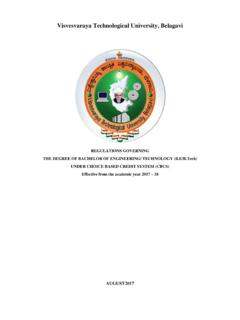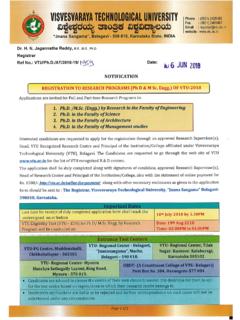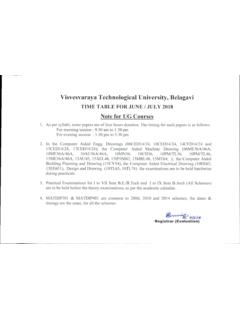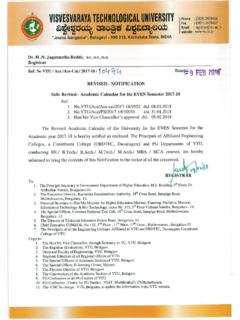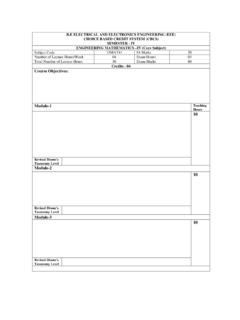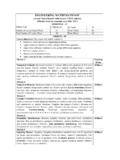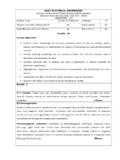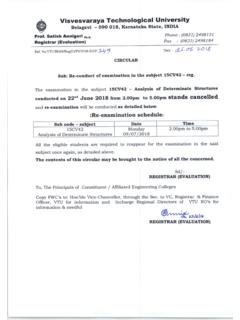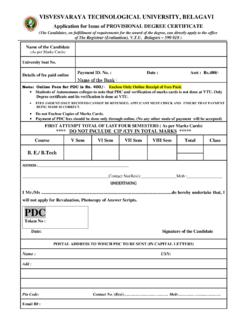Transcription of ENGINEERING MATHEMATICS-III
1 ENGINEERING MATHEMATICS-III [As per Choice Based Credit System (CBCS) scheme] (Effective from the academic year 2017 -2018) SEMESTER III Subject Code 17 MAT31 IA Marks 40 Number of Lecture Hours/Week 04 Exam Marks 60 Total Number of Lecture Hours 50 Exam Hours 03 CREDITS 04 Module -1 Teaching Hours Fourier Series: Periodic functions, Dirichlet s condition, Fourier Series of periodic functions with period 2 and with arbitrary period 2c. Fourier series of even and odd functions. Half range Fourier Series, practical harmonic analysis-Illustrative examples from ENGINEERING field.
2 10 Hours Module -2 Fourier Transforms: Infinite Fourier transforms, Fourier sine and cosine transforms. Inverse Fourier transform. Z-transform: Difference equations, basic definition, z-transform-definition, Standard z-transforms, Damping rule, Shifting rule, Initial value and final value theorems (without proof) and problems, Inverse z-transform. Applications of z-transforms to solve difference equations. 10 Hours Module 3 Statistical methods : Review of measures of central tendency and dispersion. Correlation-Karl Pearson s coefficient of correlation-problems.
3 Regression analysis- lines of regression (without proof) problems curve fitting : curve fitting by the method of least squares- fitting of the curves of the form, y = ax + b, y = ax2 + bx + c and y = aebx. numerical methods : numerical solution of algebraic and transcendental equations by Regula- Falsi Method and Newton-Raphson method. 10 Hours Module-4 Finite differences: Forward and backward differences, Newton s forward and backward interpolation formulae. Divided differences- Newton s divided difference formula. Lagrange s interpolation formula and inverse interpolation formula (all formulae without proof)-Problems.
4 numerical integration: Simpson s (1/3)th and (3/8)th rules, Weddle s rule (without proof ) Problems. 10 Hours Module-5 Vector integration: Line integrals-definition and problems, surface and volume integrals-definition, Green s theorem in a plane, Stokes and Gauss-divergence theorem(without proof) and problems. Calculus of Variations: Variation of function and Functional, variational problems. Euler s equation, Geodesics, hanging chain, problems. 10 Hours Course outcomes: After Studying this course, students will be able to Know the use of periodic signals and Fourier series to analyze circuits and system communications.
5 Explain the general linear system theory for continuous-time signals and digital signal processing using the Fourier Transform and z-transform. Employ appropriate numerical methods to solve algebraic and transcendental equations. Apply Green's Theorem, Divergence Theorem and Stokes' theorem in various applications in the field of electro-magnetic and gravitational fields and fluid flow problems. Determine the extremals of functionals and solve the simple problems of the calculus of variations. Question paper pattern: The question paper will have ten questions. There will be 2 questions from each module.
6 Each question will have questions covering all the topics under a module. The students will have to answer 5 full questions, selecting one full question from each module. Text Books: 1. B. S. Grewal," Higher ENGINEERING mathematics ", Khanna publishers, 42nd edition, 2013. 2. Ramana "Higher ENGINEERING mathematics " Tata McGraw-Hill, 2006. Reference Books: 1. N. P. Bali and Manish Goyal, "A text book of ENGINEERING mathematics " , Laxmi publications, latest edition. 2. Kreyszig, "Advanced ENGINEERING mathematics " - 9th edition, Wiley. 3. H. K Dass and Er. Rajnish Verma ,"Higher ENGINEERING mathematics ", S.
7 Chand, 1st ed. ANALOG AND DIGITAL ELECTRONICS [As per Choice Based Credit System (CBCS) scheme] (Effective from the academic year 2017 -2018) SEMESTER - III Subject Code 17CS32 IA Marks 40 Number of Lecture Hours/Week 04 Exam Marks 60 Total Number of Lecture Hours 50 Exam Hours 03 CREDITS 04 Module -1 Teaching Hours Field Effect Transistors: Junction Field Effect Transistors, MOSFETs, Differences between JFETs and MOSFETs, Biasing MOSFETs, FET Applications, CMOS Devices. Wave-Shaping Circuits: Integrated Circuit(IC) Multivibrators. Introduction to Operational Amplifier: Ideal v/s practical Opamp, Performance Parameters, Operational Amplifier Application Circuits:Peak Detector Circuit, Comparator, Active Filters, Non-Linear Amplifier, Relaxation Oscillator, Current-To-Voltage Converter, Voltage-To-Current Converter.
8 Text book 1:- Ch5: , , , , , : 16: , Ch 17: , , , , , , ) 10 Hours Module -2 The Basic Gates: Review of Basic Logic gates, Positive and Negative Logic, Introduction to HDL. Combinational Logic Circuits: Sum-of-Products Method, Truth Table to Karnaugh Map, Pairs Quads, and Octets, Karnaugh Simplifications, Don t-care Conditions, Product-of-sums Method, Product-of-sums simplifications, Simplification by Quine-McClusky Method, Hazards and Hazard covers, HDL Implementation Models. Text book 2:- Ch2: , Ch3: to 10 Hours Module 3 Data-Processing Circuits: Multiplexers, Demultiplexers, 1-of-16 Decoder, BCD to Decimal Decoders, Seven Segment Decoders, Encoders, Exclusive-OR Gates, Parity Generators and Checkers, Magnitude Comparator, Programmable Array Logic, Programmable Logic Arrays, HDL Implementation of Data Processing Circuits.
9 Arithmetic Building Blocks, Arithmetic Logic Unit Flip- Flops: RS Flip-Flops, Gated Flip-Flops, Edge-triggered RS FLIP-FLOP, Edge-triggered D FLIP-FLOPs, Edge-triggered JK FLIP-FLOPs. Text book 2:- Ch 4:- to , , , , :- to 10 Hours Module-4 Flip- Flops: FLIP-FLOP Timing, JK Master-slave FLIP-FLOP, Switch Contact Bounce Circuits, Various Representation of FLIP-FLOPs, HDL Implementation of FLIP-FLOP. Registers: Types of Registers, Serial In - Serial Out, Serial In - Parallel out, Parallel In - Serial Out, Parallel In - Parallel Out, Universal Shift Register, Applications of Shift Registers, Register implementation in HDL.
10 Counters: Asynchronous Counters, Decoding Gates, Synchronous Counters, Changing the Counter Modulus. (Text book 2:- Ch 8: , , , , Ch 9: to Ch 10: to ) 10 Hours Module-5 Counters: Decade Counters, Presettable Counters, Counter Design as a Synthesis problem, A Digital Clock, Counter Design using HDL. D/A Conversion and A/D Conversion: Variable, Resistor Networks, Binary Ladders, D/A Converters, D/A Accuracy and Resolution, A/D Converter-Simultaneous Conversion, A/D Converter-Counter Method, Continuous A/D Conversion, A/D Techniques, Dual-slope A/D Conversion, A/D Accuracy and Resolution.

